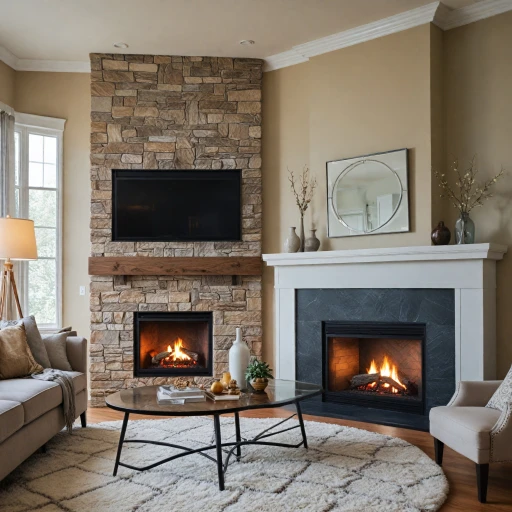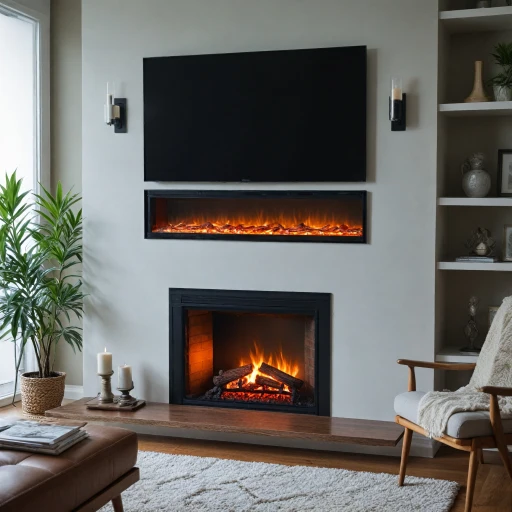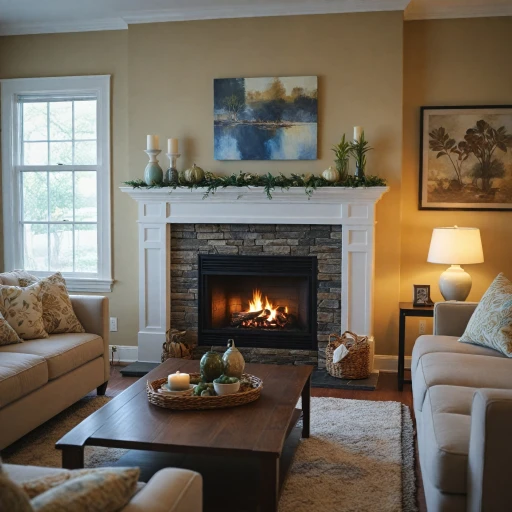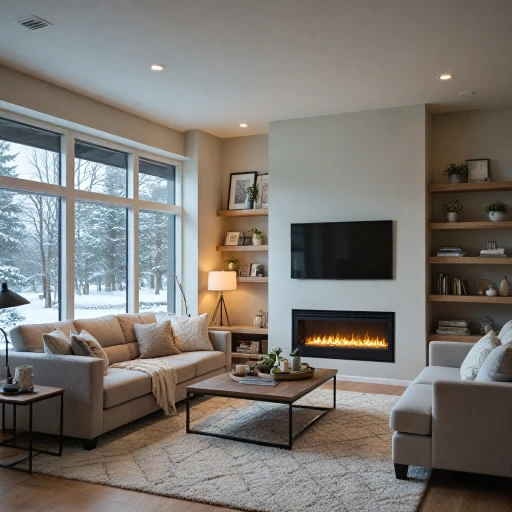
Understanding the Basics: Gas vs Electric Fireplaces
Fire and Flame: Gas and Electric Options
Gas and electric fireplaces each have their unique characteristics and suitability. If you’re considering bringing warmth to your room, it's important to understand how they differ in terms of mechanics, aesthetics, and heat output. Gas fireplaces provide that traditional, mesmerizing flame. For many, this option offers the charm of a wood-burning experience without the responsibility of handling logs and cleaning ashes. These fireplaces require natural gas or propane as a fuel source and can produce a significant amount of heat, making them excellent for large spaces and outdoor settings. Gas fireplaces, however, usually involve higher initial installation costs owing to the complexity of venting and gas line work. On the other hand, electric fireplaces are the paragon of convenience. They plug into your standard outlet, can be placed in any room, and the flames are often so realistic that they mimic their gas counterparts without the need for chopping wood or cleaning soot. The heat output might not rival gas models, but they are often considered more energy efficient, especially for smaller areas. When weighing the benefits of gas versus electric fireplaces, it’s helpful to also consider long-term maintenance and operational costs. Electric models tend to shine here as they require less frequent service and their energy costs are typically lower. Learn more about innovative ideas for electric fireplaces that could enhance your living space with modern flair. Choosing between these options often boils down to what best fits your room’s style and heating needs, as well as your own preferences for maintenance and cost-efficiency. Both boast advantages and some cons, but the right choice will align with your individual requirements and expectations.Installation and Maintenance: What to Expect
Setting Up Your Fireplace: What You Need to Know
When it comes to installing a fireplace, the process can vary significantly between gas and electric options. Each type has its own set of requirements and considerations, making it essential to understand what you're getting into before making a decision.
Installation: A Tale of Two Fireplaces
Gas fireplaces often require professional installation due to the need for a gas line connection and proper ventilation. This can mean higher initial costs and more time spent on setup. You'll need to consider the placement of the gas line and ensure compliance with local building codes. On the other hand, electric fireplaces are generally easier to install. Most models simply plug into a standard electrical outlet, making them a convenient choice for those looking to avoid complex installations.
Maintenance: Keeping the Flame Alive
Maintenance is another area where gas and electric fireplaces differ. Gas fireplaces require regular inspections to ensure the gas line and ventilation systems are functioning safely. This can add to the long-term costs and effort involved in maintaining your fireplace. Electric fireplaces, however, are relatively low-maintenance. They don't produce soot or ash, eliminating the need for regular cleaning. Simply dusting the exterior and occasionally checking the electrical components is usually sufficient.
Outdoor and Indoor Considerations
If you're considering an outdoor fireplace, gas options might be more suitable due to their higher heat output and ability to withstand outdoor conditions. However, electric fireplaces can still be used outdoors if they are designed for such use. Indoors, electric fireplaces offer flexibility in placement, as they don't require a chimney or venting system.
Innovative Ideas for Electric Fireplaces
For those interested in exploring creative ways to incorporate electric fireplaces into their home, there are innovative ideas for electric fireplaces that can inspire your design choices. From wall-mounted units to freestanding models, the possibilities are vast and varied.
Cost Considerations: Initial Investment and Long-term Expenses
Weighing the Financial Aspects
Electric fireplaces and gas fireplaces each come with unique cost structures, which could significantly impact your decision. Here's a closer look:- Initial Investment: Electric fireplaces are typically less expensive initially. You can often find a basic model for a few hundred dollars, and they don't require a complicated installation. In contrast, a gas fireplace, especially one hooked up to natural gas, may involve deeper pockets due to the cost of installation and connection fees. This can also extend to fireplaces designed for burning wood.
- Running Costs: The cost to run an electric fireplace can be quite different than that of gas. Electric fireplaces primarily consume electricity, and a typical 1,500-watt model might cost around $0.12 per hour, depending on your local electricity rates. Gas fireplaces, using natural gas, might prove more expensive, but they typically deliver a higher heat output, making this an energy efficiency consideration. For more specifics on energy usage, explore the energy consumption of electric fireplaces.
- Maintenance Expenditures: Maintaining a gas fireplace can sometimes be more intricate. They may require yearly inspections and servicing to ensure optimal performance and safety. Electric fireplaces, owing to their element-based heating and simulated flames, usually need less frequent upkeep, saving you maintenance costs over time.
- Fuel Costs: When comparing gas and electric options, fuel costs are a critical factor. Gas prices can fluctuate and often involve monthly bills that reflect your heating needs. Conversely, the cost for an electric model is more stable, reflecting only your household's electricity rate and consumption.
Energy Efficiency and Environmental Impact
Assessing Energy Savings and Green Credentials
When it comes to energy efficiency, electric fireplaces shine brightly. Unlike traditional wood burning models that release smoke and particulates into the air, these units convert electricity directly into heat. This means less energy wastage and a more environmentally friendly footprint. In fact, electric fireplaces typically operate at a higher efficiency rate, nearly 99%, since they don’t lose heat through vents or chimneys. Gas fireplaces, on the other hand, generally have heat wastage due to venting, meaning a loss of energy efficiency. They operate at around 70-85% efficiency, depending on the model and installation. Natural gas fireplaces do emit greenhouse gases, although in lesser amounts compared to wood burners.Choosing Energy-Efficient Models
When selecting a fireplace, energy efficient features are worth considering. Many electric models offer thermostatic controls and zoning capabilities, exclusively heating the space you’re using. It's the smart choice for whole house energy savings. Gas models, especially those with direct venting systems, reduce heat loss by keeping combustion air separate from room air. However, they might not achieve the same energy conservation levels as their electric counterparts.Considering Season and Usage
Seasonal changes will affect how each fireplace performs. An electric unit is ideal for quick, efficient heating in transitional seasons like fall and spring. Its quick on-off capability makes it a convenient secondary heat source. For areas outside or larger indoor spaces, a gas fireplace might be better suited. Its ability to maintain a steady heat output in the dead of winter can make all the difference in terms of comfort and coziness. Comparing gas and electric fireplaces in this context highlights the importance of weighing your priorities between consistent heat and cutting down on your energy bill.Aesthetic and Design Options
Visual Wonders and Creative Flexibility
Choosing the right fireplace design can transform a room's ambiance. Electric fireplaces stand out for their customizable aesthetic prowess. Mimicking the appearance of a genuine flame with LED light technology, these units offer quite the variety of visual experiences.- Flexibility in Design: Electric fireplaces can be installed almost anywhere, inside or even in an outdoor space, without the need for chimneys or venting systems. This enables seamless integration into modern, classic, or eclectic decor.
- Realistic Flame Effects: Advanced models deliver a lifelike flame pattern that can rival wood burning or gas counterparts. They offer adjustable flame colors and intensities to suit your mood and style.
- Variety in Styles: From sleek wall-mounted panels to traditional mantels, electric fireplaces come in various designs that can enhance any home's architectural theme.












